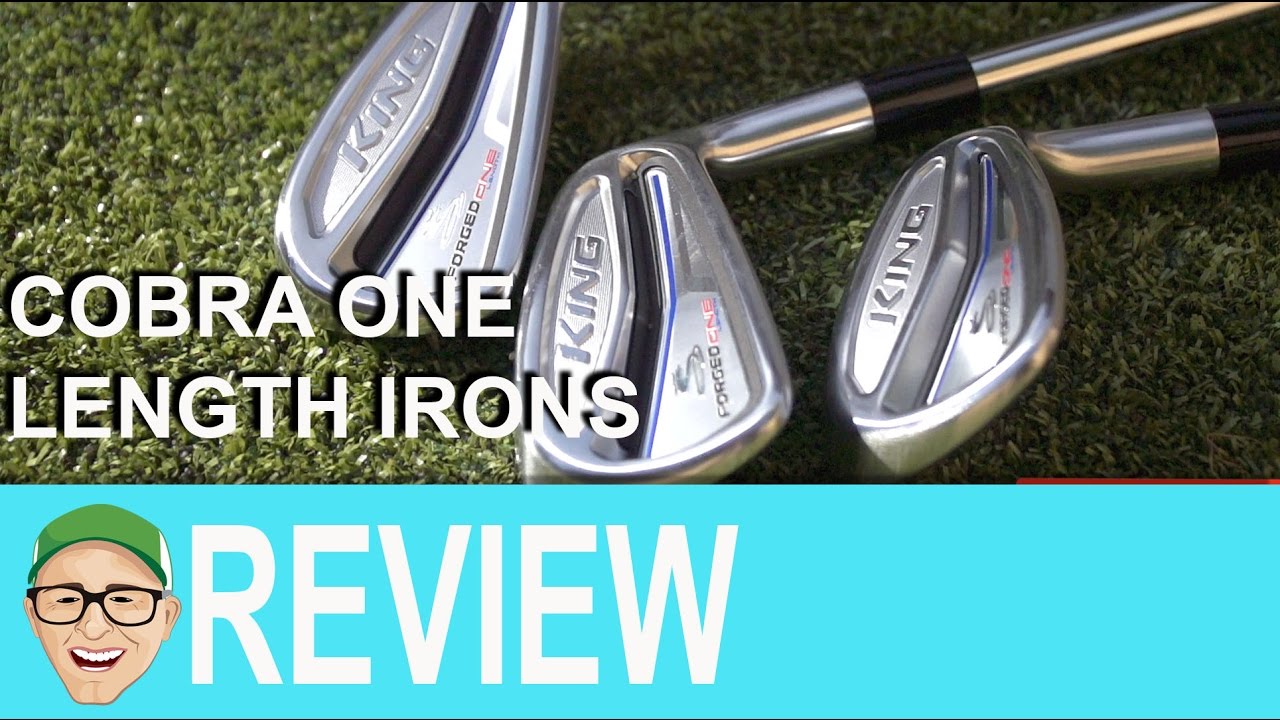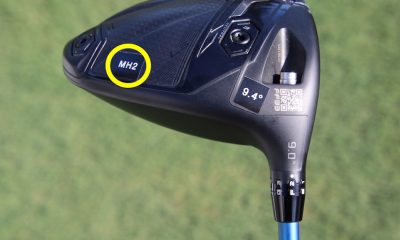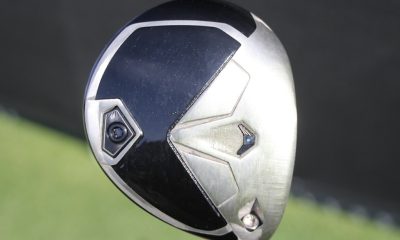Opinion & Analysis
Mark Crossfield reviews Cobra’s King Forged One-Length Irons

In this video, I review Cobra’s new King Forged One-Length irons on the course. The irons are the same model used by the PGA Tour player Bryson DeChambeau, who worked with Cobra to develop the single-length clubs.
Watch this video to see how the single-length irons — each of which is the length of a 7 iron — perform in my gap testing, and what I think of Cobra’s latest forged irons.
Related: Learn more about Cobra’s King Forged One-Length irons
Opinion & Analysis
The 2 primary challenges golf equipment companies face

As the editor-in-chief of this website and an observer of the GolfWRX forums and other online golf equipment discourse for over a decade, I’m pretty well attuned to the grunts and grumbles of a significant portion of the golf equipment purchasing spectrum. And before you accuse me of lording above all in some digital ivory tower, I’d like to offer that I worked at golf courses (public and private) for years prior to picking up my pen, so I’m well-versed in the non-degenerate golf equipment consumers out there. I touched (green)grass (retail)!
Complaints about the ills of and related to the OEMs usually follow some version of: Product cycles are too short for real innovation, tour equipment isn’t the same as retail (which is largely not true, by the way), too much is invested in marketing and not enough in R&D, top staffer X hasn’t even put the new driver in play, so it’s obviously not superior to the previous generation, prices are too high, and on and on.
Without digging into the merits of any of these claims, which I believe are mostly red herrings, I’d like to bring into view of our rangefinder what I believe to be the two primary difficulties golf equipment companies face.
One: As Terry Koehler, back when he was the CEO of Ben Hogan, told me at the time of the Ft Worth irons launch, if you can’t regularly hit the golf ball in a coin-sized area in the middle of the face, there’s not a ton that iron technology can do for you. Now, this is less true now with respect to irons than when he said it, and is less and less true by degrees as the clubs get larger (utilities, fairways, hybrids, drivers), but there remains a great deal of golf equipment truth in that statement. Think about it — which is to say, in TL;DR fashion, get lessons from a qualified instructor who will teach you about the fundamentals of repeatable impact and how the golf swing works, not just offer band-aid fixes. If you can’t repeatably deliver the golf club to the golf ball in something resembling the manner it was designed for, how can you expect to be getting the most out of the club — put another way, the maximum value from your investment?
Similarly, game improvement equipment can only improve your game if you game it. In other words, get fit for the clubs you ought to be playing rather than filling the bag with the ones you wish you could hit or used to be able to hit. Of course, don’t do this if you don’t care about performance and just want to hit a forged blade while playing off an 18 handicap. That’s absolutely fine. There were plenty of members in clubs back in the day playing Hogan Apex or Mizuno MP-32 irons who had no business doing so from a ballstriking standpoint, but they enjoyed their look, feel, and complementary qualities to their Gatsby hats and cashmere sweaters. Do what brings you a measure of joy in this maddening game.
Now, the second issue. This is not a plea for non-conforming equipment; rather, it is a statement of fact. USGA/R&A limits on every facet of golf equipment are detrimental to golf equipment manufacturers. Sure, you know this, but do you think about it as it applies to almost every element of equipment? A 500cc driver would be inherently more forgiving than a 460cc, as one with a COR measurement in excess of 0.83. 50-inch shafts. Box grooves. And on and on.
Would fewer regulations be objectively bad for the game? Would this erode its soul? Fortunately, that’s beside the point of this exercise, which is merely to point out the facts. The fact, in this case, is that equipment restrictions and regulations are the slaughterbench of an abundance of innovation in the golf equipment space. Is this for the best? Well, now I’ve asked the question twice and might as well give a partial response, I guess my answer to that would be, “It depends on what type of golf you’re playing and who you’re playing it with.”
For my part, I don’t mind embarrassing myself with vintage blades and persimmons chasing after the quasi-spiritual elevation of a well-struck shot, but that’s just me. Plenty of folks don’t give a damn if their grooves are conforming. Plenty of folks think the folks in Liberty Corner ought to add a prison to the museum for such offences. And those are just a few of the considerations for the amateur game — which doesn’t get inside the gallery ropes of the pro game…
Different strokes in the game of golf, in my humble opinion.
Anyway, I believe equipment company engineers are genuinely trying to build better equipment year over year. The marketing departments are trying to find ways to make this equipment appeal to the broadest segment of the golf market possible. All of this against (1) the backdrop of — at least for now — firm product cycles. And golfers who, with their ~15 average handicap (men), for the most part, are not striping the golf ball like Tiger in his prime and seem to have less and less time year over year to practice and improve. (2) Regulations that massively restrict what they’re able to do…
That’s the landscape as I see it and the real headwinds for golf equipment companies. No doubt, there’s more I haven’t considered, but I think the previous is a better — and better faith — point of departure when formulating any serious commentary on the golf equipment world than some of the more cynical and conspiratorial takes I hear.
Agree? Disagree? Think I’m worthy of an Adam Hadwin-esque security guard tackle? Let me know in the comments.
@golfoncbs The infamous Adam Hadwin tackle ? #golf #fyp #canada #pgatour #adamhadwin ? Ghibli-style nostalgic waltz – MaSssuguMusic
Podcasts
Fore Love of Golf: Introducing a new club concept

Episode #16 brings us Cliff McKinney. Cliff is the founder of Old Charlie Golf Club, a new club, and concept, to be built in the Florida panhandle. The model is quite interesting and aims to make great, private golf more affordable. We hope you enjoy the show!
Opinion & Analysis
On Scottie Scheffler wondering ‘What’s the point of winning?’

Last week, I came across a reel from BBC Sport on Instagram featuring Scottie Scheffler speaking to the media ahead of The Open at Royal Portrush. In it, he shared that he often wonders what the point is of wanting to win tournaments so badly — especially when he knows, deep down, that it doesn’t lead to a truly fulfilling life.
View this post on Instagram
“Is it great to be able to win tournaments and to accomplish the things I have in the game of golf? Yeah, it brings tears to my eyes just to think about it because I’ve literally worked my entire life to be good at this sport,” Scheffler said. “To have that kind of sense of accomplishment, I think, is a pretty cool feeling. To get to live out your dreams is very special, but at the end of the day, I’m not out here to inspire the next generation of golfers. I’m not out here to inspire someone to be the best player in the world, because what’s the point?”
Ironically — or perhaps perfectly — he went on to win the claret jug.
That question — what’s the point of winning? — cuts straight to the heart of the human journey.
As someone who’s spent over two decades in the trenches of professional golf, and in deep study of the mental, emotional, and spiritual dimensions of the game, I see Scottie’s inner conflict as a sign of soul evolution in motion.
I came to golf late. I wasn’t a junior standout or college All-American. At 27, I left a steady corporate job to see if I could be on the PGA Tour starting as a 14-handicap, average-length hitter. Over the years, my journey has been defined less by trophies and more by the relentless effort to navigate the deeply inequitable and gated system of professional golf — an effort that ultimately turned inward and helped me evolve as both a golfer and a person.
One perspective that helped me make sense of this inner dissonance around competition and our culture’s tendency to overvalue winning is the idea of soul evolution.
The University of Virginia’s Division of Perceptual Studies has done extensive research on reincarnation, and Netflix’s Surviving Death (Episode 6) explores the topic, too. Whether you take it literally or metaphorically, the idea that we’re on a long arc of growth — from beginner to sage elder — offers a profound perspective.
If you accept the premise literally, then terms like “young soul” and “old soul” start to hold meaning. However, even if we set the word “soul” aside, it’s easy to see that different levels of life experience produce different worldviews.
Newer souls — or people in earlier stages of their development — may be curious and kind but still lack discernment or depth. There is a naivety, and they don’t yet question as deeply, tending to see things in black and white, partly because certainty feels safer than confronting the unknown.
As we gain more experience, we begin to experiment. We test limits. We chase extreme external goals — sometimes at the expense of health, relationships, or inner peace — still operating from hunger, ambition, and the fragility of the ego.
It’s a necessary stage, but often a turbulent and unfulfilling one.
David Duval fell off the map after reaching World No. 1. Bubba Watson had his own “Is this it?” moment with his caddie, Ted Scott, after winning the Masters.
In Aaron Rodgers: Enigma, reflecting on his 2011 Super Bowl win, Rodgers said:
“Now I’ve accomplished the only thing that I really, really wanted to do in my life. Now what? I was like, ‘Did I aim at the wrong thing? Did I spend too much time thinking about stuff that ultimately doesn’t give you true happiness?’”
Jim Carrey once said, “I think everybody should get rich and famous and do everything they ever dreamed of so they can see that it’s not the answer.”
Eventually, though, something shifts.
We begin to see in shades of gray. Winning, dominating, accumulating—these pursuits lose their shine. The rewards feel more fleeting. Living in a constant state of fight-or-flight makes us feel alive, yes, but not happy and joyful.
Compassion begins to replace ambition. Love, presence, and gratitude become more fulfilling than status, profits, or trophies. We crave balance over burnout. Collaboration over competition. Meaning over metrics.
Interestingly, if we zoom out, we can apply this same model to nations and cultures. Countries, like people, have a collective “soul stage” made up of the individuals within them.
Take the United States, for example. I’d place it as a mid-level soul: highly competitive and deeply driven, but still learning emotional maturity. Still uncomfortable with nuance. Still believing that more is always better. Despite its global wins, the U.S. currently ranks just 23rd in happiness (as of 2025). You might liken it to a gifted teenager—bold, eager, and ambitious, but angsty and still figuring out how to live well and in balance. As much as a parent wants to protect their child, sometimes the child has to make their own mistakes to truly grow.
So when Scottie Scheffler wonders what the point of winning is, I don’t see someone losing strength.
I see someone evolving.
He’s beginning to look beyond the leaderboard. Beyond metrics of success that carry a lower vibration. And yet, in a poetic twist, Scheffler did go on to win The Open. But that only reinforces the point: even at the pinnacle, the question remains. And if more of us in the golf and sports world — and in U.S. culture at large — started asking similar questions, we might discover that the more meaningful trophy isn’t about accumulating or beating others at all costs.
It’s about awakening and evolving to something more than winning could ever promise.































Bo Bigelow
Jan 19, 2017 at 1:43 am
Great concept that helps simplify the game. I think single length irons will certainly help most amateur golfers strike the ball more solidly and much more consistently which will lead to better scores and therefore more fun and possibly a little faster play on the course. All of these things can benefit golf and could possibly bring more interest and more people to golf. Also, I have a bad back from years of athletics and I am going to try a set to see if they help me by not having to bend as much at address with short irons such as 9 – pw and gw.
Thank you for a great review of single length irons, Bo
John Z
Nov 5, 2016 at 10:17 pm
Actually can’t wait to give them a try
GolfMyWay
Nov 4, 2016 at 2:13 am
So, I hit the One Lengths today.
Hit the 4, 7 & PW.
They’re all the same length, same weight. That KBS FLT shaft.
I found something very interesting, and I think you will too.
What if you’re not a very good ball striker? I’m ok, a decent player, but I definitely blade-hit a few with each one, not so flush, you know what I mean? Just bladed them a bit to not catch enough grooves, may be just the bottom two. Guess what happened? I hit the 4 and the 7 almost the same distance, only about 7 yards apart. And the PW was only 10 yards behind. The 7 iron went about 185 yards, on the bladed hit. Know what I’m getting at?
What I’m getting at is, for people who are not very good ball strikers, now their distance control will be all over the place. At least with standard lengths, if you mishit a little, that bladed hit, because the shaft lengths differ, the short clubs only went as far as the shaft length will allow it, and the long irons the same, so you could expect to have that difference. Now that the shafts are all the same lengths and the headweights are the same, by blading you basically almost have the same shot with every club. That will be a huge problem.
Even on flushed shots, the 4 iron for me only went to 192 total, when I normally hit my own normal forged 4 iron to about 210. The one-length 7 went to 180, when I hit my own to about 175. Same with the PW, I hit it to about 150, but my own only goes 135. The discrepancy here with the one-length is due to its softer shaft for my feel, versus my own X-stiff shaft. I think I was spinning the 4 iron too much in the one-length and smashing the 7 iron too fast with the flexible FLT shaft.
It felt strange to hit a 4 iron so short. And the PW so long with the long shaft.
It’s not for me. The mishits would be too scary, I would fly them way too far with the shorter clubs. And the tighter distance gaps and the long irons being too short are a real problem.
I don’t think putting in my own shaft will solve that problem. I’d end up wanting to weigh the 4 iron head heavier and the PW lighter so I can have less momentum into the ball to control the flight. At that point I might as well just use the standard, traditional, variable length set.
Mat
Nov 24, 2016 at 3:05 am
I’ve hit an 8-iron 236 before. Bladed shots are irrelevant. It’s like saying a hammer is crappy as a knife.
Rimjob
Nov 3, 2016 at 3:08 am
Yeah,, like Smizzle did. So he can devote his time to typing drivel on WRX
Kevin
Nov 2, 2016 at 8:03 pm
Nice! I like the idea of a shorter-shafted 4-iron. I could see those going into my bag!
Steve S
Nov 2, 2016 at 6:35 pm
I’ve played with single length irons(Pinhawks) and found them to be ok. I’m not sure that they helped me much but I was fighting other swing issues and a back problem when I played them. It was nice to be able to set up the same for all irons. I think I’d like to try the 4 thru 7 single length again. Then use 8 thru wedges with the “standard” lengths. Might be fun now that my swing is better.
Jeff
Nov 2, 2016 at 6:19 pm
Nice review, I am intrigued by these. I thought at first the concept makes sense in the longer clubs but I was cynical about the shorter irons and wedges. It appears they just might work! Thanks
Dave r
Nov 2, 2016 at 6:00 pm
Think this would be good for young golfers just starting out , they are not all up on sponsorship what pro are hitting . And with minds like sponges it will probably work very well. Has any club producer tried this on for size ,work with a couple for a year and find out the results . Use the not the real pill for the problem and you might be surprised by all the negativity.
RthrGlf
Nov 2, 2016 at 1:38 pm
According to comments, there are still numerous variables like swing weight that prevent these clubs from being viable single-length alternative. The only single-length iron system that has been perfected over the years is 1irongolf.com. David Lake seems to cover all the bases when it comes to single length irons, such as same weight, offset, as well as simple fitting system. However, whenever there’s a new single length offering, 1irongolf’s success is never mentioned, just the failures from the distant past.
300 Yard Pro
Nov 6, 2016 at 10:08 pm
Davis Lake clubs are total garbage. They feel like kid’s K-Mart clubs. That’s why they are never mentioned.
The Sterlings and the Cobras are your only options.
Tom Newcomb
Nov 2, 2016 at 12:57 pm
Would give them a try.
jerry uritescu
Nov 2, 2016 at 5:37 am
I do like the idea of one length. It makes perfect sense to me.
Mark
Nov 2, 2016 at 1:13 am
I’ve been intrigued by these irons for a while. The gapping between irons would be my only issue. I would love to see what I could do with a set. My current irons are, Wilson FG4 with +1/2 x100 shafts. Jumbomax large grips.
Lloyd Walker
Nov 2, 2016 at 12:48 am
as im slowlng getting a bit long in the tooth if this can make it easier on me and i can be still competitive i will purchase a set , than you , lloyd
KP3
Nov 2, 2016 at 12:46 am
Also, that is kind of what Sergio does with his driver, shorter and heavier, like a 3 wood.
KP3
Nov 2, 2016 at 12:44 am
I would be interested in mixing this idea just in the long irons. Regular set up to 5 iron, then 3 and 4 iron at 5 iron length and weight. Maybe even a 2 iron.
Jo Mil
Nov 1, 2016 at 9:01 pm
I will be steering clear of any single length iron set until someone has a fitting system that will tell me what MY optimal single length is, shaft weight and flex, head weight and correspoding swing weight, lie angle, lofts, and bounce. I am not average and don’t care to be, so a one sized fits all approach does not interest me. I will wait for the company that built the irons to help Bryson win the NCAA and US Am to release their system. If it is anything like their other systems and clubs, they are focused on fitting and catering to the individual, not the masses.
Jo Mil
Nov 1, 2016 at 8:47 pm
in the absence of any type of fitting system that will tell me what MY optimal single length for all clubs is, shaft weight and flex, head weight and corresponding swing weight, lie angle, bounce, and lofts, I will be steering clear of this all together. Another attempt at catering to the “average person” and quite frankly, I am not average and care to be. I’ll wait for the company that built single length irons for Bryson when he won the NCAA’s and US Am to release their system. If it is like anything else they do, they will have thought about fitting to the individual rather than the masses.
300 Yard Pro
Nov 6, 2016 at 9:44 pm
Tom Wishon Sterlings. Never heard of them? Do you even golf bro?
Snowman
Nov 1, 2016 at 8:14 pm
I suggest folks stop worrying about integrating “woods” and wedges that are longer/shorter in length.. You will still get the benefit (if you decide there is a benefit for you) of 1 length on all your full iron shots, e.g. 4 thru GW, and that could be huge in terms of improving your ball striking and GIR which is a key for reducing your Score. I remember the old Tommy Armour EQL irons and have wondered for a while why no OEM had come out with a modern single length iron, since the tech. now makes it more practical to get the distance gapping right….which Cobra and Wishon claim they have done. The Only reason this doesn’t make sense for almost everyone is if the distance gaps are not right, that is the key thing to examine; otherwise I think these would make the game easier for most golfers.
300 Yard Pro
Nov 6, 2016 at 9:45 pm
Exactly. The benefit of the one length system comes from a full set. Not from just using 4-6.
Jt
Nov 1, 2016 at 7:54 pm
Great way review! You have me seriously considering these irons!
leo vincent
Nov 1, 2016 at 7:53 pm
The head weight numbers were confusing.I think he was trying to say how much the weight differed from a standard head weight of the same number.
nelson Radcliffe
Nov 1, 2016 at 6:29 pm
Love the idea of one length irons. I have struggled lately with irons, particularly long irons.
Jo Mil
Nov 1, 2016 at 6:10 pm
Gaps between clubs were 24 yds, 6 yds, 14 yds, 14 yds, 7 yds, 10 yds, 5 yds. Correct me if I am wrong, but that doesn’t sound good at all. Also, if each head weight is different and the shafts are all the same weight, wouldn’t you have 8 different swing weights and wouldn’t the different weights create different bend profiles and load on the shafts, therefore resulting in very inconsistent results. Unless of course, the mention of different head weights was an indication of what they had to do to get each of the standard heads to be all the same. Changing head weights to create different ball flights seems like a really bad idea to me.
Peter
Nov 1, 2016 at 4:26 pm
Anyone who is just starting to play golf would find great benefits with these irons as without doubt the majority of new golfers struggle with shafts. longer than 7/8 irons.
Thus
Nov 1, 2016 at 4:17 pm
Great review mark, I have put my name down for a set when the do get released here in New Zealand.
The idea of one length makes a lot of sense and like you said about “committing” to the shot I feel once you have crossed that bridge you will play great golf with them.
Shaun
Nov 1, 2016 at 3:54 pm
Wasn’t considering them, but the review definitely made me curious. Interesting to see Mark’s surprise at the feel and results.
Tom A
Nov 1, 2016 at 3:52 pm
Good review and thanks for taking the time to share with us.
I’m sure after a little getting use to these they would work fine for many people but I prefer to stay with standard lengths.
MP-4
Nov 1, 2016 at 2:49 pm
I wonder if Fowler will eventually move to a blade version of these considering he prefers irons that are 0.5″ short of standard?
Rimjob
Nov 2, 2016 at 2:42 pm
That’s only because he’s a short dude
RthrGlf
Nov 1, 2016 at 2:34 pm
Looks like Cobra has a great offering for one-length irons. The fitting should be easy. Just use the appropriate 7-iron length for all the clubs, assuming each club has same lie angle. What is the lie angle, anyway? Would love to win a set of these. Thanks for the review.
Martyn Edwards
Nov 1, 2016 at 2:07 pm
Interesting logic….I am going to have to give these a serious look at
Tom
Nov 1, 2016 at 2:05 pm
already half way through and mark posses some interesting question…… I’m startin to get nervous.
Branson Reynolds
Nov 1, 2016 at 1:50 pm
Was the Cobra set better than the Wishon?
Tom
Nov 1, 2016 at 1:46 pm
Great review. I particularly enjoyed how surprised Mark was when he liked these clubs.
Paul Evans
Nov 1, 2016 at 1:42 pm
Have a look at Tom Wishon’s site on Google.
Mike Zilis
Nov 1, 2016 at 1:35 pm
As a hack, I like the idea of shorter long irons and longer short irons. It’s nice to see them perform in the hands of a good player but I’d also like to see them tested by a high handicap player where the potential improvement might be more realized.
Paul
Nov 1, 2016 at 12:06 pm
just curious but does anyone know where i can find the lofts on these irons? i doesn’t look like its up on Cobras website yet.